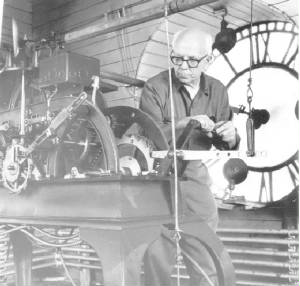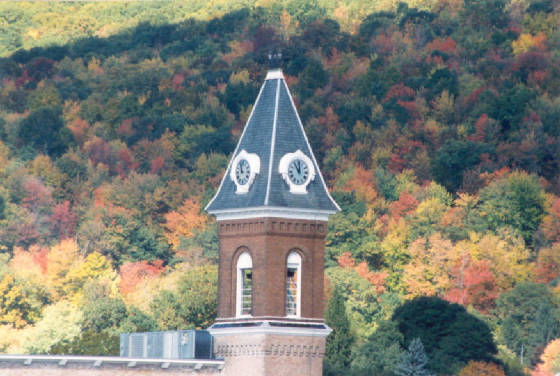
As the last band made the turn and disappeared down Ashland Street, I could almost feel the chill of an oncoming winter lurking behind the mountains. Once again, the Fall Foliage Parade brings the summer to an abrupt end. This was my fourth parade. For the last four years, each summer has boasted an ever-increasing series of events that have brought new life to the street and new hope for the next summer.
Lying underneath all that hope has been the worry that Mass MoCA would disappoint us with more delays, or that its final product would prove distant from the city, pleasing and catering only to a culture far removed from the blue collar legacy of Sprague Electric and Arnold Print Works.
Driving home from the parade, I remembered when Mass MoCA held a late-afternoon reception in August 1997, to introduce the Clock Tower Sound Sculpture. Nearly 300 locals showed up, many of them female Sprague retirees who hadn’t set foot on the factory site since it closed. It was a joyful celebration and a notable sign that the folks at MoCA were willing to tip their hats to North Adams. When the bells sounded in the tower that afternoon, it felt like the city was being awakened from a long silent sleep.
Now, a museum that was 13 frustrating years in the making is already more than four months old and headed for a cold winter of reflection and planning for next summer and a new century. So how is it doing so far? As someone who specializes in being an outside observer, who has interviewed many of the Mass MoCA staff, and who knows almost nothing about contemporary art, I offer some personal answers.
Far from distancing itself from the city, MoCA has made an obvious effort to celebrate its factory roots and to become a member of the community. The staff and the architects have done a masterful job of preserving the look and feel of the mill buildings, thereby keeping the historical connection alive. From the brick walls inside Building 4, which resemble a mural of many shades of earthy red, green, gray, and white; to the oddly beautiful bathrooms downstairs (“Is this part of the exhibit?” remarked a visitor), we are reminded of Sprague Electric everywhere we turn. Ron Kuivila’s Visitations in a dark alley in back of the visitor’s center is a loving and haunting tribute to the workers.
The computer center, the student programs, the dance parties, the Saturday morning cartoons, and the offering of their facilities to the Teen Coffeehouse are just a few examples of how MoCA is reaching out to the public. Most importantly, an inexpensive annual family fee entitles members to tour the facilities as often as they like and to attend many of the events for free. This makes the museum like a public park, and favors local citizens.
For me, most of the art is colorful, unique, surprising, challenging, and often funny. Some of it is just plain weird. I am trying, with each visit, to learn a little more about it, and it is growing on me. Its largely industrial character compliments the spaces. I especially like the 1/4 Mile or 2 Furlong Piece by Robert Rauschenberg in Building 5, and the accompanying ambient sounds that echo off the concrete floor. The long tables with the fruit in Building 4? Well, I’m still trying deal with that one.
The variety and frequency of concert events and movies have been remarkable, and The Hunter Center for the Performing Arts is a grand addition to the city. Looking back at the summer schedule in the Mass MoCA brochure, it’s hard to believe that this much could happen in North Adams in the space of four months. It certainly brought in the crowds, even if most of the visitors haven’t yet discovered the rest of our North Adams yet.
The plan to rent space to businesses couldn’t have worked out better. Building 1 is full and the next phase is completely booked even before it’s been renovated. And by avoiding the temptation to rent to trendy shops and restaurants, MoCA has followed through on its pledge not to compete with commercial downtown.
There is much room for improvement. The signs are inadequate. It is not obvious to most out-of-town visitors that a bunch of factory buildings are actually a museum, so we have to do more to lead them there. There are not enough places to sit in the galleries. In fact, there are none at the Rauschenberg exhibit, unless you count the stairs leading in.
I thought about the Mass MoCA reception and tour in April of this year, when visitors were invited to stroll unsupervised through the old buildings. A tour guide talked about the art that was going to fill the large room. Someone pointed out, “What’s here now is art, natural art.” The guide replied, “Yes, it’s so beautiful, we’re afraid it may distract visitors from the exhibits.” So why not invite people to sit and enjoy the beauty?
The outdoor café area behind the visitor’s center is messy. It’s commendable to retain the rugged factory look, but the unimproved concrete patio was usually full of standing water, and the chairs and tables were left wet after a rainy day. It’s a lovely and easily noticeable spot to sit, so why not take advantage of it?
The indoor café area presents a great opportunity to showcase North Adams for a captive audience. The far wall is an ideal place to hang photos of the city’s past and present, and there should be plenty of information about city stores, restaurants and attractions in an eye-catching and organized display. It vital to tell visitors about The Historical Society exhibits, Heritage State Park, and the Contemporary Artists Center. Downtown Development, the Chamber of Commerce, and business owners need to work hard on this over the winter if we expect to truly benefit from the influx of tourists.
With all its efforts to celebrate Sprague, Mass MoCA seems to have neglected Arnold Print Works. After all, Arnold occupied the space for a good 70 years before R.C. moved his growing business to Marshall Street. Perhaps there are fewer artifacts available, but there is plenty of information at the Historical Society and the library. Let’s offer some of it to them.
Finally, each of us must do more to connect with Mass MoCA. It’s a two-way street. I am surprised at how many people I run into who say, “I’ve got to get over there soon.” For more than 100 years, the mills at 87 Marshall Street were run by major companies that virtually “owned” North Adams. Arnold and Sprague set the standards for wages and working conditions. The clock tower told people when to get up, when to eat lunch, and when to go home.
Because Mass MoCA is a non-profit organization supported mostly by tax dollars and donations, it belongs to “US,” not to “THEM.” If there’s something you would like them to do, suggest it. If you haven’t gone there, go. If you haven’t become a member, join. If someone asks you about Mass MoCA, brag. If friends or relatives visit from out of town, take them there. When I look at Mass MoCA, I don’t see just a museum, I see North Adams. When the clock tower tolls, it still tolls for North Adams.
